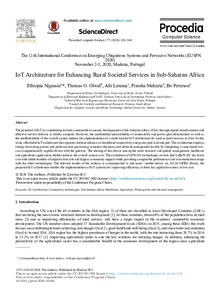IoT Architecture for Enhancing Rural Societal Services in Sub-Saharan Africa
Thomas O. Olwal; Fisseha Mekuria; Bo Peterson; Atli Lemma; Ethiopia Nigussie
https://urn.fi/URN:NBN:fi-fe2021042821324
Tiivistelmä
The
potential of IoT in contributing towards sustainable economic development in
Sub-Saharan Africa (SSA) through digital transformation and effective service
delivery is widely accepted. However, the unreliability/unavailability of
connectivity and power grid infrastructure as well as the unaffordability of
the overall system hinders the implementation of a multi-layered IoT
architecture for rural societal services in SSA. In this work, affordable IoT
architecture that operates without reliance on broadband connectivity and power
grid is developed. The architecture employs energy harvesting system and
performs data processing, actuation decisions and network management locally by
integrating a customized low-cost computationally capable device with the
gateway. The sharing of this device among the water resource and quality
management, healthcare and agriculture applications further reduces the overall
system cost. The evaluation of LPWAN technologies reveals that LoRaWAN has
lower cost with added benefits of adaptive data rate and largest community
support while providing comparable performance and communication range with the
other technologies. The relevant results of the analysis is communicated to
end-users’ mobile device via 2G/3G GPRS. Hence, the proposed IoT architecture
enables the implementation of IoT systems for improving efficiency in three key
application areas at low cost.
Kokoelmat
- Rinnakkaistallenteet [19207]
